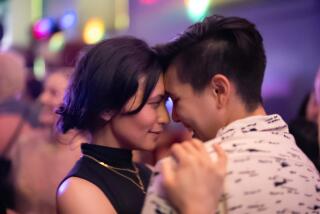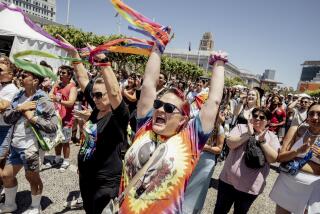Past Hostility Fades Away as Gays Show Pride in Long Beach Parade
- Share via
LONG BEACH — The sixth annual Lesbian and Gay Pride Parade and Festival went off without a hitch last weekend.
There was the usual assortment of participants ranging from flamboyant drag queens to sober-looking activists carrying signs advocating homosexual rights and the rights of AIDS patients. A group of women on motorcycles zoomed up and down the street, thrilling the crowd with their antics.
As usual, a contingent of Bible-quoting protesters took up positions near the end of the parade route, which stretched two miles along Ocean Boulevard from Cherry Avenue to Pine Avenue.
Hostility Diminished
Noticeably diminished, however, was the atmosphere of hostility and fear that once permeated the annual happening.
“We’ve come a long way,” said Judith Doyle, one of the founders of the event, who recalled that she wore a bulletproof vest in the 1985 parade because of death threats she had received.
This year Doyle rode on an open float, smiling and waving the whole way. “The atmosphere is definitely different,” she said. “There isn’t any of the emotional pressure and anger that was felt back then. This year it was an up, prideful, committed environment; we feel like we are making a statement that is being heard and respected.”
The Long Beach parade and festival was the first of a series of events scheduled throughout the country to commemorate the 20th anniversary of the police raid on Stonewall, a gay bar in New York. The June 28, 1969 raid spurred three days of rioting and is generally considered the beginning of the modern homosexual rights movement.
On a local level, organizers say, the 1989 Long Beach Lesbian and Gay Pride Parade and Festival provided a major contrast to its own beginnings, which speaks volumes about how much this city has changed.
About 500 people lined the streets to see that first parade in 1984, Doyle said. Another 8,500, she said, attended the two-day festival at Shoreline Aquatic Park.
The next year, without warning, then-City Manager John Dever issued an edict shortening the festival to one day. Dever argued that a two-day festival would tie up a popular public park too long.
Event organizers went before the City Council to appeal the move, and in a noisy meeting attended by about 300 Bible-waving protesters, persuaded the council to vote 5 to 4 to allow a two-day festival. But city officials demanded nearly $18,000 to pay for police protection during the event and that organizers purchase liability insurance worth $1 million.
ACLU Filed Suit
Acting on behalf of parade organizers, the American Civil Liberties Union filed a lawsuit charging the city with discrimination. The parade and festival went on as scheduled only after an anonymous lender stepped forward at the last minute to underwrite expenses, including the cost of the insurance.
During that year’s parade, Doyle recalls, two women riding a float sustained minor injuries after being shot with BB guns, an incident police now say they can’t confirm.
In 1986, the parade and festival were moved from their original dates in June to their current dates in May after the City Council voted against allowing the park to be used during summer months. The city also tried to ban the event altogether after organizers said they could not arrange insurance coverage. The organizers eventually won a court injunction against the ban. But the judge ruled that the city could prohibit the sale of alcohol unless organizers obtained insurance.
The 1985 lawsuit is still pending. Organizers of the event still pay for their own police protection, as do organizers of other events not involving national holidays. And since 1987, they have carried the required $1-million insurance policy that allows them to sell beer. But today, they say, their relations with the city in general couldn’t be better.
“The City Council strongly backs us,” said Bill Geiger, spokesman for the parade and festival, adding that bureaucratic hurdles once plaguing the event seem to have all but disappeared. “I’d say for the most part, it’s fairly well accepted.”
10,000 Viewers
Police estimate that this year’s parade--listed, among other places, in the monthly calendar of the Long Beach Convention and Visitors Council--was seen by about 10,000 people, 20 times the number attending the first parade. In addition, Geiger said, about 23,000 attended the two-day festival.
One obvious change since 1985, organizers say, is in the makeup of the council. Three of the four members perceived then as anti-gay have been replaced by members believed to be more supportive of homosexual issues. The fourth, Warren Harwood, says he is not anti-homosexual, and that he got a bad rap back then.
“I’ve always relied on the advice of the city attorney,” Harwood said in discussing his 1985 vote against permitting the festival to run for two days and other positions considered anathema by homosexual activists.
Mayor Ernie Kell, who as a voting member of the council often sided with Harwood on issues pertaining to the gay event, now says that his early fears regarding its propriety have been proven unfounded. “I think everyone has adjusted and they’ve done a good job of having a nice, organized parade,” said Kell, who as mayor no longer votes on issues before the council. “The parade has proven itself; there is no community opposition. This is the first year I haven’t received any hate calls.”
Community Involvement
Harwood attributes that primarily to the actions of gays themselves, who are believed to number up to 50,000 in Long Beach. “Their involvement in the community on a broad range of issues,” he said, “has very much helped familiarize the community with the leadership of the gay and lesbian community. One of the most important factors is their focus on the community as a whole, and not just the issues that might be unique to the gay and lesbian community.”
Homosexual leaders agree. In recent years, they say, gay political action committees have become involved in a variety of local issues. A recent AIDS walk, the city’s first, attracted a broad range of support from non-homosexuals. And increased education and exposure, they say, has led to a lessening of anti-gay prejudice among city residents, as well as their elected officials.
“They have real people and real issues to deal with,” Doyle said. “There is obviously a respect. I think we’ve demonstrated our viability, and that’s what it’s all about; making ourselves known so that we’re not fantasized as being something that we’re not.”
More to Read
Sign up for Essential California
The most important California stories and recommendations in your inbox every morning.
You may occasionally receive promotional content from the Los Angeles Times.










